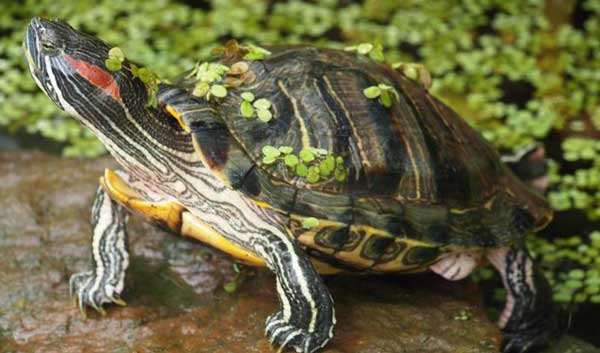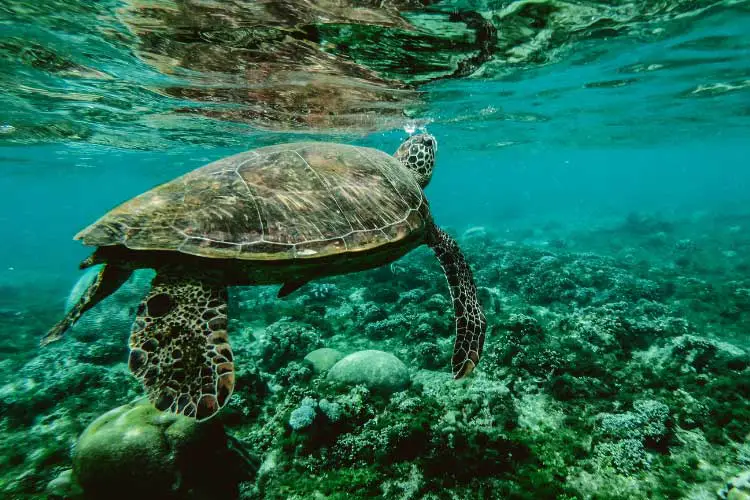Can Sea Turtles Hide in Their Shells? Common Species That Can and Can’t
It’s assumed that most animals with shells can retract and hide if threatened or in case of danger. However, some animals can’t but have other means of protecting themselves. But can sea turtles do it?
Can sea turtles hide in their shells? No, sea turtles cannot retract their heads and bodies into their shells. Their shells have adapted to suit their marine life, flattening and limiting the space inside. Among the species that can’t hide includes the green and loggerhead turtles
While sea turtles can‘t duck into their shells, some species can. Read on to learn about these species and more about sea turtles.
Can Sea Turtles Hide In Their Shell?
Contents
Turtles date back to the Triassic period, over 215 million years ago. With the ever-changing world, most species have evolved and adapted to improve their survival. However, the adaptations have limited some of their abilities.
Unlike a tortoise’s shell, which is dome-shaped with a porch, the turtle’s shell is flatter. This shell, which is a part of their vertebrate, is streamlined to allow them to swim much faster.
The shell’s shape is among the reasons sea turtles cannot retract inside fully. On the bright side, they’re much faster and better swimmers than freshwater and land turtles.

However, this does not mean sea turtles are defenseless and easy targets. Their body size and speed are among their defense against predators. They can swim faster and evade predators before getting hunted. They also have claws on the fore flippers, which they use to fight off threats.
Why Can’t Sea Turtles Hide In Their Shells?
There are various reasons why sea turtles cannot retract into their shells. They include:

1. Adapted Shells
The turtle’s shell has adapted to allow them to swim faster and more smoothly. It is more streamlined and flatter, which limits the amount of space it can hold.
They also lack a porch that tortoises and some land turtles have since it can cause drag during swimming. Turtles scavenge in many areas in the sea, and their streamlined body allows them to fight against currents
2. Body Shape
Sea turtles are more fusiform shaped, which makes them better swimmers. However, the shape limits the shell sizes, and they cannot retract fully.
3. Reduced Threat
Some species of sea turtles are big, like the leatherback, which is why they have fewer threats in the sea. Since a turtle hides in shell to protect against predators, sea turtles rarely hide. With time their bodies adapt and are unable to take some parts back in.
4. They have large limbs
Unlike land turtles, sea turtles’ flippers are large and shaped like paddles. While they help them swim faster, they are too big to retract in the shell.
Which Common Species Hide Under Their Shell and Which Don’t?
There are over 300 species of turtles in the world, including sea turtles. While most of them can hide under their shells, some cannot. The following are some species of common turtles that can and cannot hide in their shells.

What Species of Turtles Can Hide in Their Shells?
Following are some common types of turtles that can hide in their shells

1. Snapping Turtles
Snapping turtles are among the common pet turtles that are popular due to their strong jaws. They can fight off the threat and also hide in their shell.
2. Red-eared slider Turtle
Red-eared slider turtles are popular pets, mostly for their attractive markings. You can notice your turtle hiding in the shell when threatened or fearful.
3. Mud Turtles
Mud turtles are small reptiles, between 3 and 4 inches, and make great outdoor or indoor pets. They can fully retract in the shell when they feel threatened in self-defense.
4. Box Turtles
Box turtles don’t get too large and are prey to raccoons, crows, and coyotes. They can successfully retract in their shells when they detect threats.
5. Western Pond Turtles
Western ponds are among the endangered species of turtles, and they’re prey to osprey, otters, and coyotes. They hide in their shells for protection but often take cover under rocks or logs.
Which Turtle Species Cannot Hide in Their Shells?

The following are some turtles that cannot retract into their shells.
1. Loggerhead Turtle
Loggerheads are among the sea turtles that can’t retreat in their shell but possess powerful jaw muscles to fight threats.
2. Leatherback Turtle
The leatherbacks are the biggest living turtles and use their size for protection because they can’t retreat into their shells.
3. Green Sea Turtle
The green sea turtle uses their great swimming speed and camouflage to protect against threats. They are among the species that are not able to hide in their shells from a threat.
4. Flatback Sea Turtle
With predators like sharks and crocodiles, flatback sea turtles depend on their speed for survival. Like most sea turtles, they cannot fully retract their parts but are fairly fast swimmers.
5. Musk Turtles
Pet fans adore Musk turtles for their curious personalities. Since they can’t hide well under their shells, they use Rathke glands to produce a predator-deterrent scent.
Some of the above turtle species that can retract their head are Suborder Cryptodira which retract the head straight back. The others belong to the suborder Pleurodira and fold their necks sideways into the shell.
What Are the Risks of The Turtle Not Hiding in Their Shells?
Most turtles’ shells are hard and used as protection against threats. However, the turtle must successfully retract all its parts to be protected. The turtles who can’t retract fully are at various risks discussed below

They Can’t Hide from Predators
While sea turtles might be fast in the sea, their flippers don’t do that well on land. During the breeding season, when they lay eggs on the shores, they are vulnerable to predator attacks.
Since they cannot hide in their shells, they’re easy targets to predators like coyotes and foxes who can eat them.
Likely To Entangle in Marine Debris
Since sea turtles cannot retract back into their shell, they risk getting entangled in marine debris. A lost fishing gear, like a fishing net or floating debris, can hold and drown a turtle.
By retracting into the shell, a turtle can free tangled libs. A stuck turtle is at risk of getting eaten by predators in the sea.
Disturbance From Humans
Humans who don’t know that turtles can’t retract their heads in their shells often disturb them. They assume the turtles are welcoming and not worried because they’re not hiding. Disturbing these reptiles can end up stressing them too much, and it’s highly discouraging.
FAQs
If you still have some remaining doubts that need to be cleared, the following section got you covered.
Most times, when you see a turtle retracting its head, it’s likely due to fear. They hide when scared or threatened by a predator to protect themselves.
A turtle hiding in the shell might mean they’re fearful or sleeping. You can observe and fix anything in their surroundings that might be stressing it.
Since they cannot fully retract their body under their shells, most sea turtles burrow themselves in mud. Their shells provide protection, as well as camouflage from predators above.
Bottom Line
Although most turtles carry a shell on their back, not all use it for protection as some do. Sea turtles are among the ones who cannot hide under their shell, mainly due to their shell shape. Also, their body parts are bigger and unable to fit under their shells.
They risk getting eaten, entangled by marine debris, or picked by humans. However, they are fast and have different ways to protect themselves against these threats.



